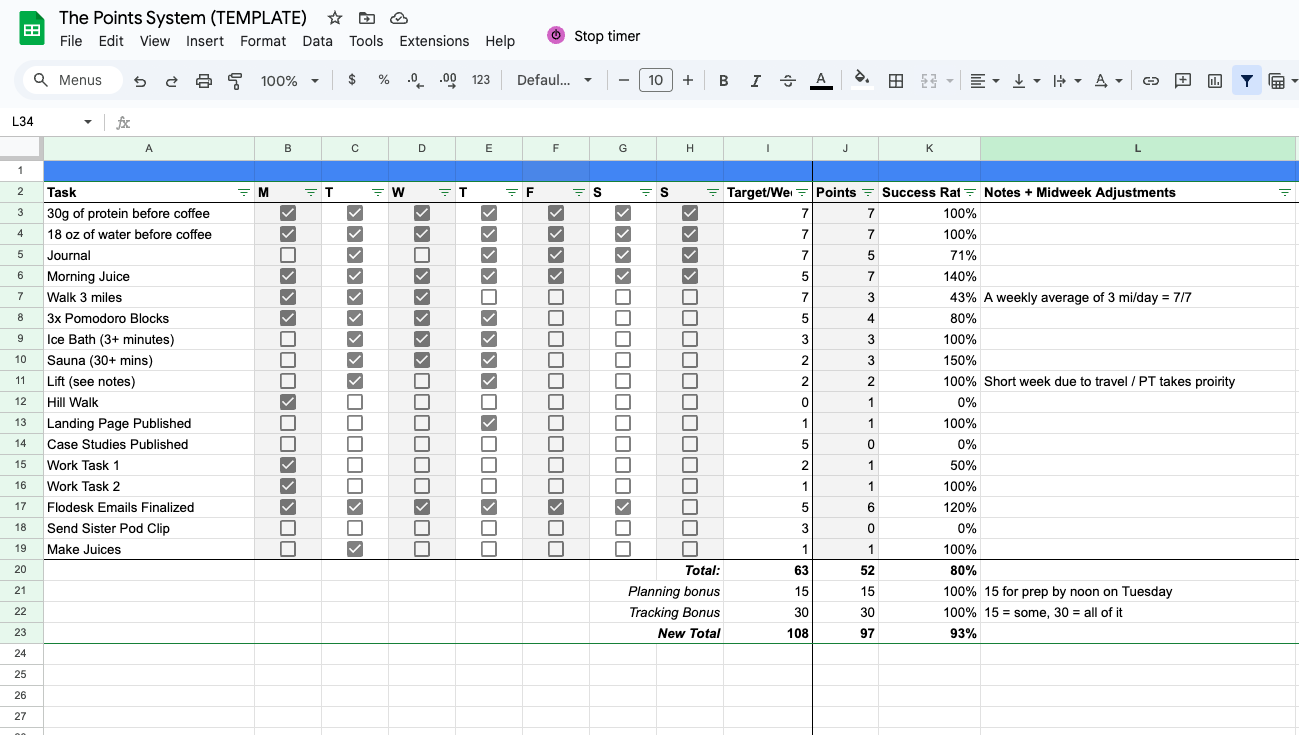The Points System (Part 1)
Finding structure in an unpredictable season of life through the art of surrender and a spreadsheet that keeps score
The Unexpected Athlete
One of the things you hear all the time in entrepreneur spaces is “take care of yourself first.” And to be honest, one of the weirdest parts of running a business is realizing just how connected my health and my work are—my self-care, my motivation, my nutrition, my activity levels. It’s the most athletic I’ve ever felt in my life.
Which is funny, because I was a college athlete. Back then, my "system" was simple: show up to practice, survive, repeat. I could eat like garbage and still perform. But entrepreneurship? Whole different ballgame. Now, the coach is me. The stakes are higher. And the opponent? My own unrealistic expectations.
The Math Problem That Wasn’t
Let me tell you, I have a habit of setting completely unhinged goals. Like, “write a book in 20 days” levels of unhinged. Because in theory, it should be possible, right? Ten pages a day, ten days for edits—boom, done.
That’s not how the creative process works. That’s not how anything works. And yet, for years, I kept treating my goals like math equations instead of… reality.
2024: A Comedy of Horrors
Last year? It was chaos. A comedy of horrors.
A lot of things I had taken for granted—routine, predictability, a sense of continuity—just disappeared. My client work was all over the place. My doctor’s appointments were all over Los Angeles. I did multiple rounds of physical therapy. My ability to plan? Gone.
I even tried to trick myself into feeling in control. I made my Google Calendar so pretty—like, five or six times. Didn’t matter. The moment I tried to stick to it, life came along and laughed in my face.
So, I had to surrender. And in doing that, I had to find a new way to track my life that actually worked.
The Realistic Guide to Keeping Score
I needed a way to track macro trends over time—not in a rigid, do this every day or fail forever kind of way, but something that let me see progress even when life was chaotic.
So, here’s how it works:
Every week, I make a list of tasks I want to complete.
There’s a column for each day of the week, where I check things off.
Some things are daily (like journaling or drinking water before coffee), some are weekly (like getting in two solid work blocks).
At the end of the week, I total it up.
Simple. Flexible. Practical.
No Morality, Just Data
Here’s the key thing: there’s no morality attached to any of it.
Dyeing my hair? Same amount of points as going on a three-mile walk. Lifting weights? Literally the same as journaling.
It’s not about worthiness—it’s about follow-through. The goal is to track my reality, not punish myself for not meeting some arbitrary ideal. Because if I’ve learned anything from 2024 (and prior), it’s that even the best plans get derailed by things out of my control—getting sick, family emergencies, unexpected opportunities, or just life.
Proof of Concept = Confidence
One of the craziest things I’ve learned in the past six months? Having proof of concept gives me confidence.
If I can see something in 3D—if I can track it, measure it, and witness the progress—I believe in it. But when I don’t have that reference point, it’s like it never happened.
So, this system? It’s my way of proving to myself, week over week, month over month, that I am doing the things I set out to do. Even in an unpredictable season, even when things feel like a mess, I have a way to see my own effort—and that’s what really counts.
What’s Next?
I’m still refining the system, but I’m excited to start tracking monthly and quarterly trends and seeing how things shift over time. Right now, I’m just getting back into lifting, returning to my step goals, and figuring out what’s sustainable long-term.
And honestly? It feels good. To let go of the weird, punishing expectations and just focus on doing the things.
More on that in Part 2. But for now—if you’ve ever struggled with feeling like you’re failing at your own goals, maybe it’s not you. Maybe it’s just time to change how you’re keeping score.
P.S. If you’d like to see a visual, here is a screenshot of the form + a link to view it on Google Drive.



